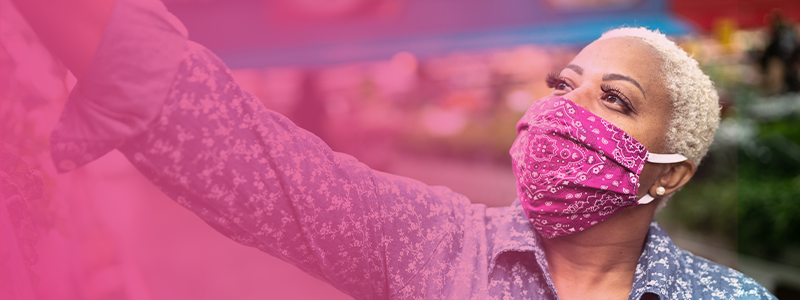
Besides travel and hospitality, no other industry has been devastated by the COVID-19 pandemic as much as retail:
- Almost three-quarters (72.5%) of Canadian retailers have seen a lower demand for their products or services due to the coronavirus.1
- Over 60% of Canadian retailers are expected to report a decline in revenue greater than 20% once the pandemic subsides.2
- Combined, retail businesses in Germany, France and the United Kingdom are projected to lose £3.2 billion.3
- More than half (52.7%) of U.S. consumers are avoiding in-store shopping trips as a result of COVID-19.4
- Because of the pandemic, 23% of retail companies are renegotiating store leases, 18% are closing store locations outright, and 2% are breaking leases.5
Historical Global Disruptions and Their Impact on the Retail Industry
Prior to the onset of a once-in-a-lifetime pandemic, the retail industry has been hit hard due to other global disruptions:
- September 11, 2001: Immediately after the 9/11 attacks, retail sales dropped6 by an estimated 2%.7
- Northeast Blackout of 2003: U.S. retailers lost between $380 million USD and $940 million USD in consumer goods, most of which were food products gone to waste.8/li>
- 1973 Energy Crisis: The average price of gas rose 43% in the U.S.9 and nearly 50% in Canada.10 With costs going up and availability going down, consumers were forced to curb their driving and retail habits. It’s estimated that a one-time 1% increase in energy prices in any given month will lead to a drop in retail consumption by approximately 0.15% within the next 12 months.11
- World War II: From 1941 to 1944, the average U.S. household spent 6.5% less on retail items such as food, furnishings, recreation/entertainment and transportation compared to the years leading up to the war.12
- 2008 Global Financial Crisis: When the global economy collapsed, people simply stopped shopping and U.S. retail sales plunged to a 35-year low of approximately 11%.13 In Canada, retailers experienced a decline of 2.9% while employment in retail dropped 1.7%.14 Italy saw retail sales shrink by an average of 3.5% per month.15
3 Ways Mobile Technology Future-Proofs Your Retail Business Against Global Disruptions
Interruptions have occurred before and they will inevitably happen again. But with smart planning and the use of modern mobile technology, retailers can protect themselves against the next global disruption, whenever and whatever it will be.
1. Provide Multiple Delivery Options
During times of global disruption, people tend to stay home more than usual. Either out of necessity (COVID-19) or by choice (“cocooning” after 9/11).
But people still need to buy and receive products, even if they’re avoiding brick and mortar stores.
According to the SOTI State of Mobility in Retail Report, 31% of consumers are comfortable with emerging delivery methods such as drones and 27% are open to the idea of autonomous vehicle delivery.
By providing delivery choices, retailers are also future-proofing against global disruptions. For example, eco-conscious consumers may prefer to receive their purchases from an electric vehicle. With this option, retailers are accessing a new customer base, and protecting themselves against the instability of oil price volatility and potential government-mandated restrictions, like with physical distancing.
2. End-to-End Supply Chain Visibility
Many disruptions, such as war or a global pandemic, result in lockdowns or restrictions. COVID-19 has closed the borders of at least 145 countries and territories around the world.16
Yet, goods still need to flow from manufacturers to retailers and ultimately, consumers. For retailers, this means having real-time insight into their transportation and logistics operations:
- Inventory: How much is being generated? How much is available? How much demand is there? (After 9/11, there was increased demand for make-at-home comfort foods like macaroni and cheese, lasagna and mashed potatoes.17)
- Route: How are the goods being shipped? Are multiple modes of transportation (plane to boat to train to truck) required? If access to, or through, certain jurisdictions is restricted, are alternative routes available?
The supply chain is a tightly controlled industry. When a global disruption strikes, new regulations are introduced, and existing ones are strictly enforced. The right Enterprise Mobility Management (EMM) solution ensures things like the quality of shipping documents and other legal and compliance requirements are met. This mitigates against major delays in times of uncertainty and effectively gets products into the hands of retailers during times of increased demand.
Also, retailers who implement and manage Internet of Things (IoT) technology, such as tracking-and-tracing, can monitor vehicle location and performance, and even optimize routes too.
Meanwhile, radio-frequency identification (RFID) tags can keep track of inventory and stock levels from the moment the product leaves the manufacturer’s warehouse.18
3. Use Mobile Technology to Get People into Your Stores…and Out Fast
In a six-month span, 79% of smartphone owners have made a purchase from their device.19 Although more people are using smartphones from shopping to shipping than ever before, there are still those (58%) who enjoy the brick and mortar shopping experience.20
In times of global disruption, it benefits the retailer and customer if those experiences are as fast as possible. This can be due to things like public health (in the case of COVID-19) or scarcity and uncertainty (35% of shops in Coventry, UK were destroyed during the Blitz in World War II21).
There are numerous ways mobile technology allows retailers to keep their doors open and helps customers quickly find what they need:
- Scan-as-you-go technology: Shoppers scan the items they plan to purchase. When done, they simply pay for the order using contactless payment technology and walk out the store.
- Beacon technology: An app tracks a customer’s movements throughout a store. When they reach specific areas, beacon technology serves up product-related information and promotions to help the customer decide if they want to purchase an item or not.
- Mobile checkout: Who says the checkout area needs to be at the front of a store? Mobile technology allows customers to pay for items anywhere in the store – outside a dressing room, in a grocery aisle or even from the shopping cart itself.
- Buy online, pick up in store (BOPIS): An emerging trend for 50% of Canadian shoppers22 and 70% of U.S. shoppers23, BOPIS offers the best of both worlds – the time to browse and pay online and the convenience of walking into a store, picking up your purchase and walking right back out.
Future-Proof Your Retail Business with SOTI
The best time to get your retail business ready for the next major global disruption is right now. The best solution to help you do it is the SOTI ONE Platform, an integrated suite of solutions designed to help keep your business-critical mobile operations running smoothly even when the world isn’t:
- SOTI Snap lets you quickly build and deploy the apps your retail workers need to deliver effective, efficient customer service during times of disruption.
- Use SOTI MobiControl to get full visibility into where your field devices are, who’s using them and how they’re being used.
- With SOTI Assist, you can provide remote diagnostic help desk support when device issues occur. It’s the ideal solution to minimize downtime in periods of uncertainty.
- SOTI Insight delivers out-of-the-box analytics on metrics like app and data usage, location and battery health, to maximize device performance and reliability when it’s needed most.
- SOTI Connect provides full lifecycle management of IoT devices, such as printers, and alerts you and takes remediation actions when problems are detected.
- SOTI Identity gives you secure, single sign-on access to the SOTI ONE Platform from anywhere in the world, which is ideal when disruptions force you and your team out of the office to work remotely.
- Collaborate and share knowledge with SOTI customers, partners and product experts from around the world by connecting to the SOTI Central online community.
Contact SOTI Today
Of the global disruptions listed above, SOTI has helped retail businesses through four of them: COVID-19, the Northeast Blackout of 2003, 9/11 and the 2008 Financial Crisis.
We don’t know when, where or what the next big disruption will be. But we want you to be ready for it.
Contact us to learn more about our products and services. You can also begin to future-proof your retail business now by requesting a demo of the SOTI ONE Platform, or starting your free 30-day trial.
- Statistics Canada, Canadian Survey on Business Conditions: Impact of COVID-19 on Businesses in Canada
- Statistics Canada, Canadian Survey on Business Conditions: Impact of COVID-19 on Businesses in Canada
- Statista, Expected Cumulative Impact of Lost Retail Sales By the Coronavirus Outbreak in the UK, Germany, and France
- Statista, Likeliness of Consumers to Avoid In-Store Shopping Because of COVID-19 in the US
- Forbes, How Retailers are Responding to the Pandemic and Preparing for Reopening
- Holland & Knight, The Retail Industry in 2002
- Brookings, Forecasting the Economy and Policy After 9/11
- AEG, Northeast Blackout Likely to Reduce US Earnings by $6.4 Billion
- Wikipedia, 1973 Oil Crisis Immediate Economic Effects
- CBC, 1970s Gas Prices
- Edelstein and Kilian, Retail Energy Prices and Consumer Expenditures
- US Bureau of Labor Statistics, Consumer Spending in World War II
- NY Times, Retail Sales are Lowest in 35 Years
- Statistics Canada, Canada Year Book: Retail and Wholesale Trade
- VoxEU, Italy, Before and After Lehman Brothers
- COVID-19 Travel Alerts, Lockdowns and Border Closures
- Psychology Today, How Terrorist Attacks Influence Consumer Behaviors
- CIO, 4 Ways Retailers Can Improve Supply Chain Management
- OuterBox Design, Mobile eCommerce Stats in 2019
- 365Retail, 5 Ways to Future Proof Your Business for 2019
- IWM, The Blitz Around Britain
- Square, BOPIS Might Be the Thing You Need
- Digital Commerce 360, BOPIS is the Next Wave or eCommerce



